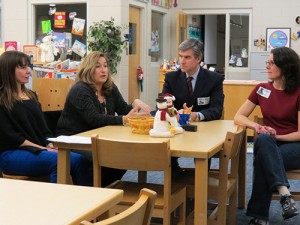
OCEAN CITY — Health literacy in Americans, especially youth, is despairingly low, but a new campaign at Ocean City Elementary aiming to improve literacy at an early age could help turn that around.
The program is in the pilot stage at OCES and officials hope that it could eventually see integration across multiple grade levels and schools. The health literacy project is a partnership between Worcester County Public Schools and Atlantic General Hospital (AGH) and the Herschel S. Horowitz Center for Health Literacy at the University of Maryland-College Park’s School of Public Health. The goal is to impart skills to students in grades K-12 that help them make healthy choices in the real world.
“If we can build these understandings and skills now, it can help prevent problems later,” said Linda Aldoory, director of the Center for Health Literacy at the University of Maryland-College Park.
It is separate from standard health education because health literacy is designed to be taught organically, integrated directly into established lesson plans for subjects like math and reading.
“The special part we found about the program is that we didn’t just create a health literacy lesson,” said Cynthia Leitgeb, a second-grade teacher at OCES. “We actually incorporated it into a reading lesson that we already would have been doing.”
The reading lesson included a story that mentioned portions on a dinner plate, which Leitgeb’s class was able to discuss naturally as they continued the lesson. It felt organic, said Leitgeb, and as stories touch on different subjects it’s easy to emphasis the health literacy parts.
“We were able to incorporate math, different science aspects,” she said. “When we talked about growing a garden and talking about different ingredients.”
As a pilot focused exclusively on second-graders at OCES, the health literacy project has a lot of room to grow. The most important thing that it is doing this year, according to Aldoory, is gathering data that can be used to further the program. Right now there is very little research on health literacy in youth and what little does exist usually doesn’t extend all the way down to second-graders.
“The youngest research has been with adolescents,” said Aldoory.
That kind of health literacy tends to focus on teen issues like substance abuse and sexual health. While vital, the common teen health literacy doesn’t touch on some of the basics like understanding portion control, critically reading nutritional labels or appreciating the need for regular physical activity.
There’s a lot of room for a more fundamental kind of health literacy that seeks to lay a foundation for healthy choices in young students and can grow with them into adulthood. This is crucial, since health literacy is extremely low across the board.
“According to a national study, more than half of the U.S. adult population has basic to below basic health literacy,” read a release from AGH. “Even people with strong literacy skills in general struggle with health literacy. Another study, conducted by the U.S. Department of Education, showed that only 12-percent of Americans have proficient health literacy skills.”
The effects of this can be seen early in life, with the rate of obesity in teens averaging 10 percent. Less than a quarter of adolescents report eating five fruits and vegetables per day and even fewer, 17 percent, report getting a minimum of 20 minutes of vigorous activity every day. This has a huge effect on many aspects of a person’s life.
“When you’re not prepared as a consumer to deal with balancing all of those issues, then it makes it very difficult, very stressful and it makes health outcomes worse. It prevents us as a society from moving forward and advancing,” said Michael Franklin, president and CEO of AGH.
Aldoory and her team will be returning to OCES in June to measure the results of the early pilot program. So far, eight formal health literacy lesson plans have been established, but they leave a large amount of flexibility about how and when they’re implemented. If the pilot goes well, Worcester County Public Schools will likely be phasing in similar programs across the county.
“From there, we’re really expecting for this to be integrated in multiple grade levels,” said Tamara Mills, Coordinator of Instruction, “depending upon the schools, the strengths and weaknesses of each school, so we are really looking to make this across the grades as time goes.”
Local school leadership is supportive of a focus on health literacy, Mills continued, as officials see it as going far beyond just learning how to read nutritional labels. The program allows for a “trans-disciplinary approach” with an emphasis on Science, Technology, Engineering and Math (STEM) learning.
Through the pilot and beyond, AGH has signaled its commitment to raising the health literacy of youth in Worcester. AGH is routinely available for both physical and virtual tours for students.
“We are fortunate to have a great hospital right here on the Eastern Shore in Berlin, Md.,” said OCES Principal Dawn Rogers. “And, again, for the students, it can’t be too early to learn what it provides for them.”
